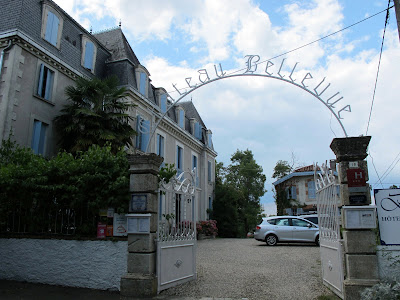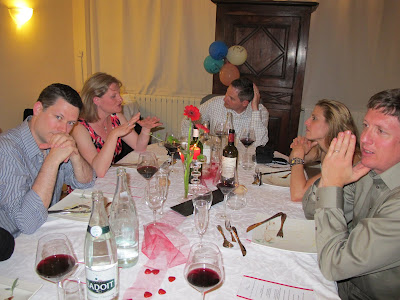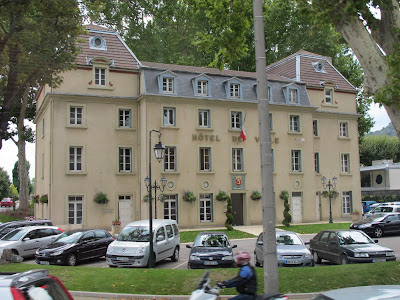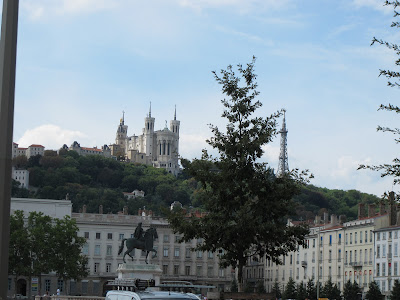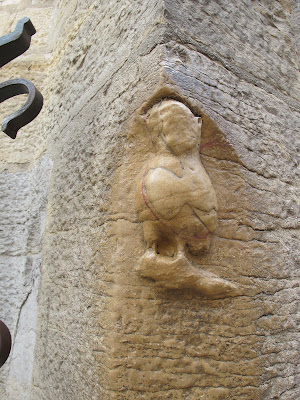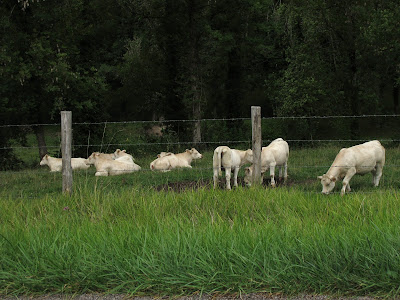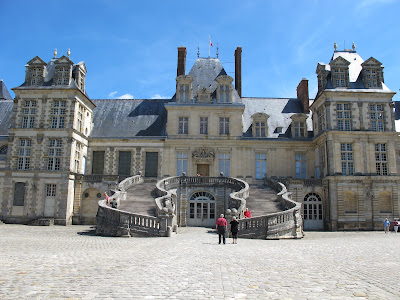Bill and I celebrated our 50th Anniversary with a trip to France Charlotte Southern France, while others came and went. I have to give credit here to Bill’s planning. He did the heavy lifting on getting this four-part adventure organized—along with our faithful travel agent Nita. For part one, we flew to Bordeaux Carcassonne Rhone River Orly Paris
PART 1: BEFORE THE CELEBRATION
PART 1: BEFORE THE CELEBRATION
What could be a more beautiful season to be in France? Sunflowers are a food crop, but they do wonders for the scenery as well.
They also make a nice backdrop for a picture. However, within a couple of days of our arrival the blooms faded and began to dry.
Carcassone is the largest walled city in France, and it's largely intact. It was interesting, but packed with tourists.
Carcassonne is really more romantic from a distance.
One of the trip themes was Bill's search for Cathar castles. We visited several. This one, Puivert, is an example. The Cathars were a religious group in the 11th through 13th Centuries who were at odds with the Catholic Church for a variety of reasons. They were considered dangerous heretics and were, therefore, wiped out.
Our visit to the 12th Century Cathar castle at Puivert came complete with "reenactors."
Bill is working on his life list of small countries. On this trip we went into the Pyrenees so he could add Andorra. We expected Andorra to be rural and quaint, like this French Pyrenees Mountain scene.
What we actually found in Andorra were thriving cities in an economic boom, as evidenced by the building cranes. It's all about ski resorts and private banks.
PART 2: CAZAUBON AREA AND THE PARTY
Chateau Bellevue in Cazaubon, built in the 18th Century and beautifully restored and modernized by the Consolaro/Latrielle family, was our home base in Gers for a week. This is the entry and front of the hotel, with the family home in the former stables on the right.
The terrace of Chateau Bellevue overlooking the grounds offers an opportunity to relax or dine.
Our younger generations enjoyed the pool at Chateau Bellevue.
Cazaubon is a bastide, which is a fortified town that developed in Gascony in the middle ages, especially during the Hundred Years War. The town still maintains much of its traditional character. The village has a bull ring, offering about a dozen no-kill bullfights a year.
This is the "new" church in Cazaubon, built in the 16th Century and still an active parish. The weekly market is set up in the areas in front and below the church.
This is the "old" church in Cazaubon, which dates back to the 14th Century. The space is still used by the community, but not as a church.
Cazaubon is a village with character and a history. Many homes are several hundred years old, but the residents and the community take care of them. Workers were busy re-doing the paving stones in the streets when we were there.
About six kilometers from Cazaubon is the spa town of Barbotan-les-Thermes, which we visited on its Saturday market day.
From our home base at Chateau Bellevue, we visited several other places in the area. This is the tower at the 13th Century bastide (fortified town) of Larressingle, the smallest remaining intact walled town in France. Carcassonne is the largest. Grandson Henry found this to be the perfect place to work on his somersaults.
Fellow travelers Sue and Norm Loomer at lunch in Larissingle.
Eric and Jenn at lunch in Larissingle
After lunch in Larissingle, we visited the Gallo-Roman villa of Seviac, where we took this portrait of Pamela and Henry. TheSeviac excavations reveal a classic Roman home of the period from the 2nd to the 7th Centuries, with multiple rooms around a square courtyard surrounded by arcades with marble columns. There is a second courtyard that provides access to the private baths, of which there are two sets. The smaller was for daily use and the larger more sumptuous for special occasions. One can visualize the luxury lifestyle of the Roman occupants. The mosaic floors are amazingly well preserved.
One of many Seviac mosaics
THE BIG EVENT CELEBRATING OUR 50 YEARS OF MARRIAGE
To all the Consolaro-Latrielle family, to the Chateau Bellevue staff, and to the family and friends who came from afar to help us celebrate, thank you!
Rob, Pamela, Steve, Susan, and Eric
Bill, Judy, Steve, and Allen
Dan and Beverly--married in February and now on their honeymoon
Norm, Bill N., Allen, Rob, Steve, Dan, Jenn, Eric
Sue, Judy, Mindy, Jean, Bill W., Beverly, Pamela, Susan
Henry, Libby, Oliver
Cousins Henry, Oliver, and Libby
Jean, wearing a scarf from special friend Fay, and Bill--
loving life and each other
The Chateau Bellevue Family: Michele, Emilie, Charlotte, and Thomas
The first of seven courses...
...and the last
The day after the party, our friends from early Ripon days, Jean Grant and Bob Fraga, arrived from their home near Bergerac to spend a day with us.
Since Ripon College puts a major focus on cycling, we paid a visit to Notre-Dame des Cyclistes.
The chapel is all that remains of a 12th century fortress of the Knights Templar. On 18 May 1959, Pope John XXIII agreed to the wish of Father Joseph Massie, making the old chapel a National Sanctuary of Cycling and Cyclists under the protection of the Virgin: Our Lady of cyclists (Notre Dame des Cyclistes). The Tour de France has passed the chapel four times: in 1984, 1989, 1995 and 2000. There was also a departure from neaby La Bastide d'Armagnac on July 9, 1989. Our daughter Jennifer spent the summer of 1989 at Chateau Bellevue and saw the Tour de France riders pass by.
Pamela, Jean G., Norm, Sue, Libby, Bill W., Oliver, Henry, Jean, Bill N., Bob, Judy, Rob, Steve
PART 3: PORTRAITS OF SOUTHERN FRANCE--A WEEK ON THE RHONE RIVER
The Roman arena at Arles
The cafe of the painting by Van Gogh, "The Café Terrace on the Place du Forum, Arles, at Night"
The Papal Palace at Avignon from the River
Grapes, grapes, grapes...wine, wine, wine
Jean, Bill, Bill, and Judy in their element
Châteauneuf-du-Pape grapes love growing in rocks, which warm during the day and keep the temperature pretty consistent at night.
We went through 15 locks on the Rhone trip, and I enjoyed watching from the sun deck.
Tain-l'-Hermitage City Hall
We did a tour and wine tasting at Tain-l'-Hermitage.Domaine du Murinais, owned and operated by a young couple who are experimenting with sustainable, organic methods.
The Viking Neptune docked at Tournon
Roman Temple in Vienne
The Basilica de Notre Dame and metal Metal Tower on Fourvière Hill in Lyon
View of Lyon from Fourvière Hill
Friday night street music in Macon
Jack and Bev Christ at dinner on the Neptune
This tower is one of the few original remnants of the once-thriving Abbey of Cluny, a Benedictine monestery from the 10th Century. A lot of the abbey has been restored and the imagination is assisted by models and rotating computer-generated pictures.
This place, with its plain front, is truly amazing. It's in Beaune and it's called the Hostel-Dieu. It was founded in 1443 by Nicolas Rolin, chancellor of the Duke of Burgundy, and his wife, Guigone de Salins. Our guide said Nicolas' charity was motivated by his desire to earn his way to heaven, but it did benefit the poor and sick.
On the inside the Hostel-Dieu loses its plain look. Those colorful tile roofs are typical in Burgundy, by the way.
The Hostel-Dieu is now a museum, but the vineyards associated with it continue to produce good wine, which is auctioned each year to benefit the poor.
PART 4: TOURING BY CAR AFTER THE CRUISE
Several cities we visited had walking tours marked by these little sidewalk brasses bearing local mascots. This one, in Dijon, is an owl. The owl it depicts is on the side of the cathedral and is said to bring good luck to those who touched it, which, of course, we did.
This is the famous little cathedral owl.
The Dukes of Burgundy lived well in Dijon. This is one room in their palace.
Jean Grant pointed out that Jeanne d'Arc can be found in nearly all cathedrals, so we began looking for her. This one is in Ste. Etienne Cathedral in Dijon.
The River Serein in Chablis
The Dovecote of Fontenay Abbey
The Château de Tanlay at Tanlay (Yonne) was built in Burgundy during the sixteenth and seventeenth centuries. Since 1700 the property has remained in the family of the man who was created marquis de Tanlay in 1705. This is an overview of the front of the chateau.
This side view of Château de Tanlay shows the moat.
Burgundy is famous for white cows as well as vineyards. They are raised for beef, not milk.
Croque Monsieur and salad is a good standby bar lunch. It's a hot ham and cheese (typically emmental or gruyère) grilled sandwich. Goes well with a tapper.
Statue of French novelist Nicolas Retif de la Bretonne in the main square in Auxerre
Ste. Etienne (Stephen) Cathedral in Auxerre
A view from the hilltop inVézelay
Auberge Vieux Moulins Banaux was a wonderful find! It's in a historic old mill, the rooms are clean and comfortable, the view is exquisite, and the food at the restaurant was delicious.
Fontainebleau is all about Napoleon. This is his throne room.
Napoleon said his farewell from this horseshoe staircase at Fontainebleau before going into exile.
It was a splendid vacation; we couldn't have asked for better. But, at the end, isn't it nice to come back to a home we love? This was the sunrise that greeted me in the back yard the day after we returned.








